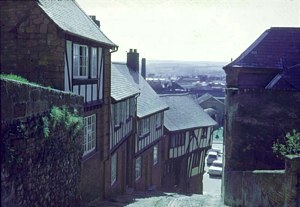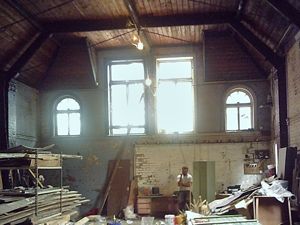
The Hall, Stepcote Hill
Formerly the Parish Hall and Sunday School for St Mary Steps Church
Page added 16th September 2013
Back to Buildings of
Exeter
Also see The Hall
The old St Mary Steps Sunday School, on Stepcote Hill, is a Grade II* listed building, which is being renovated and converted for use by The Hall, Exeter, a Community Arts and Social Club. It was a private dwelling for a number of years, but before that, it was a Parish Hall, Sunday School, gym for soldiers during the war, and a small theatre.
The original idea for a hall for St Mary Steps Church, that could be used both as a general parish hall and a Sunday School building was proposed by the Rev. Cecil Square, who in his first year as rector (1888) had said that his church warden had suggested ‘that such a room would be a fine thing for the parish’. After a sermon one Sunday evening, members of the Church of England Workingmen’s Society promised their support, and an appeal was made to influential people of the city to donate. An initial £100 was raised, by the end of the first phase of the scheme. The Workingmen’s Society withdrew, as they felt they did not have enough influence to take the scheme further, and a committee was formed, and more fundraising planned. The Rev. Square resigned from the post due to ill health in February 1891.
In January 1889 a concert was given at the Rougemont in aid of the proposed new parish room for St Mary Steps.
The Mayor, Mr E H Houlditch opened a two-day bazaar at the Arcade, for raising funds to build the proposed Sunday School and Parish Rooms. It was stated that £300 was still needed to complete the building of the rooms, behind the church. It was estimated that £600 was required in total for the project, and £400 had already been given. The site, which cost £300, had been part of an old tenement on Stepcote Hill.
The laying of the foundation stone for the new Sunday Schools and Parish Room was on the 13th October 1892. After a church service, the congregation went to the site for the new hall, where Lady Northcote performed the ceremony, attended by Sir Stafford Northcote. A public luncheon was given after the event, at the College Hall, South Street.
The site which fronted Stepcote Hill, was 54 ft by 26 ft, immediately behind St Mary Steps Church. The interior would have revolving shutters, allowing the main hall to be one open space, or be divided into smaller class rooms.
Adding a choir and vestry
In July 1894, a committee was set up to plan a new choir vestry which would join the existing Sunday School room to the church.
Fund raising commenced for the vestry, and an entertainment by Captain J Boucher at the Royal Public Rooms was staged on February 5th 1895. The two shows were a mixture of songs and sketches, with all proceeds towards the building fund for the proposed additions to the Sunday School Rooms.
In December 1895 the committee of the St Mary Steps parish room and Sunday Schools accepted the tender, from Messrs Westcott, Austin and White of Exeter, for the completion of the vestry under the superintendence of Mr Edward G Warren architect.
It was in September 1896 that the Bishop of Exeter formerly opened the new Sunday School room and adjoining vestry, for St Mary’s Step parish. As is customary at the time, a tea was held in the new buildings after the ceremony.
The Great War
A St Mary Steps Sunday School teacher, Private W Tapper a bandsman of the Devons who went to India in October 1914, died of disease in Mesopotamia in 1916. Private Tapper was a popular member of St Mary’s Steps’ Institute in which he took a keen interest and was also a member of the St Mary’s Steps Church being a chorister as well as a teacher.
In the same year that Private Tapper died, at a presentation at the Parish Hall, the Rev. H P Burdett was given a gold watch, and an illuminated album containing a list of names of the subscribers to mark his twenty-fifth anniversary as rector of the church. A large gathering of parishioners were told that the Rev Burdett had accomplished much during his time at the church, including the completion of the Sunday School building.
In 1930, at the time when many of the West Quarters residents were being moved out to Burnthouse Lane, a commission appointed by the Bishop of Exeter suggested that seventeen of Exeter’s parishes should be amalgamated into three. The Rev HP Burdett Rector at the St Mary’s Steps was interviewed and said that many of his old parishioners who had moved to Burnthouse Lane still attended St Mary’s Steps on Sundays, and their children still attended the Sunday School next door.
During the war the building was used as a gym for soldiers. In 1959 it was converted into a small theatre for the amateur Exeter Drama Company. The company produced many shows over the intervening years, and is still producing up to four shows a year at The Shed, Alphington Village Hall. Then around about 2005 the premises became a private dwelling.
The Hall, Exeter, Community Arts and Social Club, is hoping to complete their renovation of the old Parish Hall by 2015, and once again, this old public hall will be used for the benefit of the community.
Sources: Western Times, Exeter Gazette, Trewmans Flying Post and the The Hall website.
 The
old Sunday School is the building on the right.
The
old Sunday School is the building on the right.
 The interior of the old Sunday School. Photo Richard Holladay.
The interior of the old Sunday School. Photo Richard Holladay.│ Top of Page │